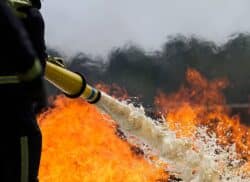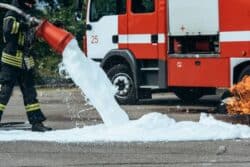What Chemicals Are in Firefighter Foam?

At least some of the chemicals in firefighter foam are known toxins that have been linked to cancer in adults and developmental delays and other conditions in children. This type of toxic contamination has had a devastating effect on families across the United States.
If you have been following the legal cases filed against foam manufacturers and other parties, you know that a certain type of firefighting foam is toxic and that you can seek compensation with help from an attorney. Our nationwide network of lawyers can help.
Does Firefighting Foam Still Contain PFAS?
PFAS, or polyfluoroalkyl substances, are toxic chemicals used in many types of products. According to the Environmental Protection Agency (EPA), thousands of chemicals are classified as PFAS. They have a wide range of uses, including firefighting foam.
Although we now know about the dangers these chemicals pose, older foams produced before the public realized firefighting foam is toxic could still be in use by organizations that either:
- Are not fully aware of the dangers PFAS pose
- Do not care about the damage PFAS can do to people and the environment
- Cannot afford to throw out and replace old foam stock
Some communities have made efforts to protect the public from toxin-containing firefighting foams. For example, just a few years ago, the state of Massachusetts announced a “take-back program” designed to remove older, more dangerous foams from use. In addition, the state of Washington banned PFAS in firefighting foam, per the Washington State Department of Health (DOH).
Per the EPA, PFAS can remain in the environment for a very long time. Even if every manufacturer stopped using them tomorrow, the already-existing chemicals could continue to do serious harm.
Properties of Firefighting Foam
To combat fires, firefighting foam must contain the following properties:
- Resistance to heat: It may seem obvious, but foam must not melt or lose effectiveness when exposed to high temperatures. One of its main purposes is to cool down the impacted area.
- Vapor suppression: When some materials burn, they let off harmful gasses. A good foam should stop the spread of these gasses as well as the flames themselves.
- Ability to tolerate fuel: Firefighting foam must be an all-purpose product that efficiently stops fire, even in the presence of accelerants like gasoline. If fuel is present, the foam must cover and cool it so it doesn’t also ignite.
- Ability to tolerate alcohol: Alcohol, like fuel, is flammable and can both start and worsen a fire. Firefighting foam must work just as well against alcohol as any other substance.
- Ability to spread quickly: Foam must be able to cover a fire rapidly and completely. If it moves too slowly, the fire could continue to spread.
PFAS are common in firefighting foam in part because they support each of these necessary properties. They are not, however, the only firefighting tools available. The continued use of PFAS is therefore an unnecessary hazard to both the environment and the public.
AFFF Firefighting Foam
AFFF is short for aqueous film-forming foam. It is a white substance that can be sprayed over a fire. Its purpose is threefold:
- To smother the flames themselves
- To cover and stop the fire-spreading potential of any flammable materials (e.g., gasoline or alcohol)
- To cool down the entire area
AFFF has been used to fight fires caused by liquid fuel or other substances that do not react as well to water or other fire suppressants. However, there is a significant downside: its dependence on toxic chemicals like PFAS.
Who Uses AFFF?
In the past, PFAS were often used in AFFF to ensure they embodied all of the properties discussed above and could fight fires effectively. Several companies manufacture this type of foam, including:
- 3M
- DuPont
- Chemours Co.
- Tyco Fire Products, L.P.
AFFF is used by many different types of organizations, including airports, oil refineries, factories, and even the U.S. military.
Many parties could’ve contributed to your exposure to AFFF, from manufacturers to employers. For this reason, you could potentially file a lawsuit against multiple parties.
Firefighting Foam Health Effects
AFFF firefighting foam has been linked to a range of health problems, including:
- Various cancers
- Thyroid issues
- Kidney issues
- Metabolic syndrome
- Liver problems
- High blood pressure
- Developmental issues in children
If you or someone you love suffered any of these health issues after exposure to AFFF, you could be entitled to compensation. To receive that compensation, you would need to prove that:
- You were exposed to AFFF: For example, you could show proof that you were in the military if the exposure occurred during service, or you could show a piece of mail you received while living in a contaminated area.
- You have an official diagnosis: Only a doctor can say for sure whether you have a particular condition. Medical records can also prove you received treatment for which you should be reimbursed.
- Your condition is linked to AFFF exposure: This is not a criminal trial, so you do not have to prove “beyond reasonable doubt” that the AFFF caused your illness. However, you will need to show a reasonable amount of proof, such as a doctor’s opinion stating that the illness is at least as likely as not linked to AFFF exposure (as opposed to any other risk factors you encountered).
- Your condition has negatively impacted you: This impact could be on your physical health, your mental health, your ability to provide for your family, your ability to enjoy life, or even your property (if you own land that was contaminated by PFAS-containing AFFF, for example).
A toxic contamination lawsuit attorney can help you collect enough evidence to prove each of the above points.
Does Firefighting Foam Cause Cancer?
According to the National Cancer Institute (NCI), PFAS have been classified as a “possible human carcinogen” for years. A carcinogen is any material that is known or suspected to increase a person’s risk of developing cancer.
In other words, while exposure to PFAS does not guarantee you will develop cancer, your chances of developing any of the following types of cancer may increase with exposure:
- Prostate cancer
- Testicular cancer
- Uterine cancer
- Endometrial cancer
- Kidney cancer
- Thyroid cancer
- Non-Hodgkin’s lymphoma
The longer you are exposed to carcinogens, the greater your risk may be of developing cancer.
PFAS are not the only carcinogens out there. This is why the court will expect you to present evidence that demonstrates the AFFF is a likely cause of your cancer as opposed to other carcinogens recognized by the National Toxicology Program (NTP), such as:
- Asbestos
- Benzene
- Erionite
- Formaldehyde
Firefighting Foam Contamination
AFFF is sprayed over any area that is on fire and is designed to stay there for as long as necessary. Unfortunately, this can cause the PFAS in AFFF to enter the surrounding environment by soaking into the ground and even getting into local water supplies. You can therefore still be exposed to PFAS even if you were never anywhere near the fire.
Plaintiffs claim to have been exposed to AFFF in different ways. Consider the following examples:
- A firefighter who uses PFAS-containing AFFF on a regular basis throughout their decades-long career develops kidney cancer years later.
- A pregnant woman drinks water contaminated by AFFF, and her child is born with a low birth weight, which increases the risk of infant mortality, according to the World Health Organization (WHO).
- An army captain’s spouse is exposed to AFFF during his in the military. The spouse later develops metabolic syndrome and suffers a stroke.
All of these individuals could have good reason to file a lawsuit for damages. If they can prove the firefighting foam chemicals likely contributed to their health problems, they could receive compensation for everything they have lost or suffered as a result.
Why Do Firefighters Use Foam Instead of Water?
While water can combat many types of fires, it cannot put out all of the fires that firefighters encounter, especially if they work in areas where gasoline, oil, and similar substances are present. For instance, using water in the following situations can endanger others and worsen the fire:
- Candles: Candle wax serves as fuel for a fire, and adding water can make it spread even faster.
- Grease: Like wax, cooking grease spreads very rapidly when exposed to water.
- Gasoline: As the National Library of Medicine (NLM) states, water can keep materials cool after exposure to a gasoline fire and protect firefighters, but it cannot stop the fire itself.
Foam, unlike water, can extinguish these types of fires quickly. Firefighters use it so they are prepared to face any kind of fire at a moment’s notice.
Firefighting Foam Lawsuits
It’s been clear for years that firefighter foam is toxic. Due to the dangers posed by PFAS, thousands of people around the country have filed lawsuits against one or more organizations responsible for their exposure, including:
- Manufacturers like 3M or DuPont
- Employers that allowed workers to continue using AFFF despite knowing (or the fact that they should have known) about the health risks
- Utility companies responsible for water safety
As of September 2022, over 2,500 such cases have been combined into a single legal action called multidistrict litigation (MDL). This is just one example of the many legal actions that have been filed against foam manufacturers and other parties over the years.
Individual Suits versus Mass Torts Against Firefighter Foam Manufacturers
There are several ways you can seek damages after AFFF exposure, including:
- An individual lawsuit: By filing a suit by yourself, you and your lawyer would have to confront the liable party on your own, even if they have more power and resources than you.
- A class action lawsuit: In a class action, plaintiffs combine their cases into one big case. This allows them to share in both the legal costs and the resources they need to fight a large organization. They also share whatever compensation they win.
- A multidistrict litigation: MDLs are similar to class actions in that they allow plaintiffs to share resources to fight a bigger defendant. However, their cases are still considered individually rather than grouped into a single case.
Everyone’s situation is different, so it might be difficult for you to decide which of these options is right for you without a lawyer’s help. An attorney can elaborate on the differences between your options and assess your situation to determine how best to develop your case.
What Else Can an Attorney Do?
Your attorney can handle all of the legal tasks associated with a lawsuit, such as:
- Identifying who should be the target of your lawsuit (e.g., a manufacturer or someone else)
- Collecting medical records and working with physicians to determine how much your treatment could cost over time
- Calculating how much money you could be entitled to receive
- Filing your case singly or joining a preexisting class action or MDL
- Contacting the liable party and their representatives about your lawsuit
- Managing communications with other parties by taking phone calls and sending or receiving documentation
They would also be there to support you throughout the case, advising you on how to deal with all of the big questions that may arise. Hiring an attorney to manage your lawsuit means that you are never alone. From the start of your case until the very end, you would have the comfort and reassurance of knowing that a legal professional is in your corner, fighting for your rights.
You Can Sue the Firefighter Foam Manufacturers
If you were exposed to firefighter foam containing toxic chemicals and were subsequently injured or made sick, you have the right to ask for an attorney’s help in building a case against the liable party. We can put you in touch with a lawyer from our network that serves your area and has experience with mass torts. Call 1.844.44TORTS (1.844.448.6787) or contact us online to be connected with a mass torts lawyer in our network.


